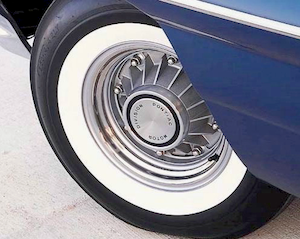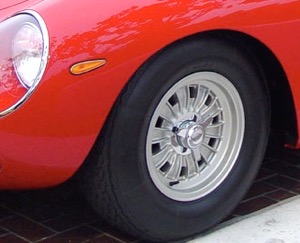by James Kraus

1968 BMW 2800CS riding on unusually elegant alloy wheels featuring a polished chrome centre cap discreetly concealing the mounting lugs. Visible fasteners on a contemporary automobile are generally considered to represent a lack of refinement, yet seem to be embraced when they appear on otherwise highly stylized wheels. These were produced for BMW in Italy by FPS (Foundry Pedrini Siena).
Today, alloy wheels are all but ubiquitous and are used by automobile manufacturers as a key styling feature, often used to differentiate model ranges and equipment specification. They started becoming popular with the general public in the 1980’s, but were in fact offered sporadically since 1924.
Previous to the development of the alloy wheel, wheels were formed of two pieces of pressed steel, the rim and the disc, either welded or riveted into a single unit. Or, they were fabricated of a steel or aluminium rim, connected to a centre hub by metal spokes. A transitional design was a hybrid utilizing a steel disc for strength and an aluminium rim for weight saving. Such a design was used by Porsche and Jaguar in the 1950’s. Another example was the Borrani Bimetal, used on several Italian sporting models.
Cast or forged alloy wheels offer reduced weight and greater stiffness than stamped pressed steel wheels. They also offer the designer almost unlimited freedom in terms of style.

Bugatti Type 35
The use of cast aluminium wheels was premiered by Ettore Bugatti on his Type 35 in 1924. These wheels incorporated an integrally-cast brake drum. In addition to a considerable weight saving over a conventional wheel and separate brake drum, the Bugatti’s wheels acted as large heat sinks to provide improved brake cooling. Bugatti continued development on cast wheels of this type, culminating in the massive 24-inch 8-lug version used on the Type 41 Royale.

Panhard PL 17
After World War II, Panhard developed a radially finned aluminium brake drum that doubled as the wheel centre with a bolted-on steel rim supporting the tyre.

1956 Cadillac Coupe de Ville. Lars Schenk photo
In late 1954 Cadillac introduced their Sabre-Spoke aluminium wheel, manufactured by Kelsey-Hayes. Standard on the ’55 Eldorado, it was available as an option on the rest of the Cadillac line. The stylized forged aluminium centre and outer rim was riveted to a steel inner rim. This multi-finned wheel was normally chrome-plated, but for 1956 only, the gold anodized finish shown above was also available. Last produced for the 1958 models, Cadillac would not offer another alloy wheel to the public until 1981.

1961 Pontiac Star Chief
In 1960, Pontiac introduced their version of the aluminium integrated wheel and brake drum. Separate steel rims were secured to the finned aluminium centres by eight chrome-plated acorn nuts. Vehicles with these wheels came equipped with an adapter plate stowed with the spare wheel that allowed for the open-centre rims to mate with conventional wheel balancing machines.
Available through 1968, these were an expensive and rare option now sought after by collectors. Like the earlier Panhard and Cadillac wheels, these had a centre cap large enough to cover the mounting lugs.

OSCA 1600 GT Fissore. Jim Houlgrave photo
OSCA commenced production of their 1600 GT in 1961, fitting the car with Amadori cast magnesium wheels sporting large centre caps.

Abarth 850 TC Corsa
Ever the innovator, Carlo Abarth began offering a variety of magnesium wheels manufactured by Campagnolo on most Abarth models in 1962.

Ferrari 275 GTB/C
Ferrari began offering their first alloy wheel, the magnesium Cromodora Starburst for road-going versions of the 275 GTB in 1964 as an alternative to the classic Borrani wire-spoke wheels. In competition however, the Scuderia still preferred the Borranis for a few more seasons. In 1967, a 275 GTB/C was the last Ferrari factory competition car to enter into battle with traditional wire wheels.

1964 Chevrolet Corvette Sting Ray
In 1964, the Corvette became available with centre-lock Kelsey-Hayes aluminium wheels. These were changed to a bolt-on version for 1967. Later that year, the Corvette C3 was introduced and the aluminium wheel discontinued. This finned design was the first and only light-alloy wheel to be available on the Corvette until eight years later when a new style was introduced as an option on 1976 models.

Alfa Giulia Sprint GTA Stradale
1965 saw the debut of the Alfa Romeo GTA, a performance version of the Giulia Sprint featuring a number of special lightweight components, among which were a set of light-alloy Campagnolo wheels.

1965 Ford Mustang G.T. 350
The 1965 Mustang G.T. 350 was offered with optional Shelby/Cragar five-spoke wheels consisting of a cast aluminium centre section and chromed-steel rim. Rather than being riveted together like the Cadillac Sabre wheels, the aluminium centre incorporated cast-in steel tabs that were welded to the steel rim. The following year, a one-piece cast aluminium ten-spoke wheel became available.

Lamborghini Miura
When Lamborghini first exhibited the bodyless Muira chassis at the 1965 Salone dell’automobile di Torino, it was equipped with Borrani wire wheels in accordance with Lamborghini tradition; but by the time the completed car was shown at the 1966 Salon de Genève, it was sitting on magnesium Campagnolos.

1966 AC Cobra 427 S/C
Halibrand magnesium wheels were legendary among the American racing fraternity since the dawn of the 1950s, used on everything from Indianapolis racers and dragsters to the Ford GT40. They were eventually specified on road cars by Carroll Shelby.
Many Halibrand wheels were finished in Dow #7 protective coating which gave them a distinctive matte golden-bronze colour. Wheels finished in this manner would later be widely seen on Ferrari Formula One and Sports Racing cars in the 1960s and 1970s.

Fiat Dino Coupé
The Fiat Dino, which debuted in 1966, was fitted with exclusively with these six-spoke Cromodora alloy wheels with chrome center caps. Fiat later offered a similar five-spoke version as an option on the 124 Coupé and Spider.

1967 Porsche 911S
Porsche introduced their first alloy wheel in 1966 as standard fitment on the new 911S. This forged aluminium wheel was manufactured by Fuchs and remained a fixture on the 911 for two decades in 14, 15 and 16-inch diameters, ranging from 4.5 to 9-inches in width. They also saw duty on the 912, 914/6 and 944.

NSU Ro 80
In 1967, Fuchs provided a very similar wheel for the radically new Wankel rotary-engined NSU Ro 80.

Toyota 2000GT
Toyota introduced their new 2000GT in ’67, equipping it with a set of cast magnesium centre-lock wheels.

Maserati Ghibli. Takeyoshi photo
The same year, Maserati offered their first aluminium wheel on the new Ghibli.

Aston Martin DBS V8
Aston Martin introduced their first alloy wheel on the new DBS V8 in 1969.

Mercedes-Benz 300 SEL
Mercedes joined in the fray in 1970 with a forged aluminium Fuchs wheel known variously as the Baroque or Bundt Cake. This design would go on to survive for over a decade (although later versions were made of cast aluminium) in 14 and 15-inch diameters and a variety of widths. It was available on all Mercedes-Benz passenger cars except the 600. The 1982 debut of the 190 Series saw the introduction of a new Mercedes smooth-face alloy wheel that would eventually supplant the Bundt Cake across the range.

Capri RS 2600
The Minilite wheel was probably the most popular aftermarket wheel ever, ubiquitous on both road and track for decades. Originally developed for the BMC Mini and produced in cast magnesium, the Minilite made its competition debut in February of 1964.
Minilites were eventually available in a full range of sizes in both magnesium and aluminium. They were used by factory competition teams everywhere from European rallying to the U.S. Trans-Am championship. In 1970 the Minilite was fitted as original equipment on the Ford Capri Mk I RS 2600 GT Lightweight.

1975 Volkswagen Scirocco LS
The first factory-fitted all-alloy wheel widely available to the motorist of moderate means was the cast aluminium 12-spoke, 5 x 13″ version offered as optional equipment on the original first-series VW Golf, Scirocco, Passat and Audi 80 beginning in 1974.
Early alloy wheels enjoyed long production runs and were used across several models and design generations. They became marque signifiers in their own right in many cases, with the original Porsche Fuchs forged-aluminium wheel a signature feature of the 911 from 1966 through 1989 and the Mercedes Bundt Cake wheel lasting from 1970 through 1985.
And as Steve Jobs would say… one more thing:

Citroën SM
The Citroën SM (1970-1973) was available with a technologically advanced steel-reinforced engineered resin composite RR (Résine Renforcée) wheel, developed with Michelin. An SM piloted by Jean Deschaseaux and Jean Plassard won the grueling Rally of Morocco on these lightweight plastic wheels in 1971.
The BMW 2800CS wheel you mention has always been one of my personal favorites along with the near-identical Campagnolo design used on the Fiat Dino. Not only does the chrome cap lend a nice finished appearance, it provides a great contrast to the matte gray finish of the wheel.
Shortly after the Ferrari 275 GTB became available with the Cromodora Starburst, the factory began offering a smooth-faced 10-hole Campagnolo alloy wheel as well.
The Giugiaro-designed Maserati Bora of 1971 had Campagnolo wheels similar in concept to the design they created for the Dino, having rather striking large concave brushed stainless steel discs in the center. These covers were unique in that they were unadorned, containing no center emblem or logo, and were styled to compliment the Bora’s brushed stainless steel roof:
The Mercedes Fuchs Bundt Cake wheel has always been a favorite especially coming from a company as design conservative as Mercedes.
C’Bell! I am curious about the Similarity between the early BMW ‘5 slotted’ ‘CS MAGS’ and Ferrair/FIAT DINO Spyder and GT/4 ‘6 Slotted Wheels’… They are both Quite Qool/Similar looking, and am wondering if it is just Coincidence or some Manufacturer {Whom?} made them for Both BMW and Ferrari/FIAT, around the same time period. They both LOOK Italian…
I am also curious about the Bolt Patterns, and Hubcap FIT…IF the Ferrari Wheels/HubCaps will Fit on my ’70 BMW 2800CS.. MOTORE!, giade
Both wheels were indeed made in Italy. FPS manufactured the BMW wheel, and Cromodora produced the Dino wheel. The two are not interchangeable because the BMW bolt circle is 120 mm and the Dino is 108 mm.
Great post.
The Italiane FPS Wheels on the BMW E9s are also Magnesium?
I am not 100% sure; but to the best of my knowledge, the FPS BMW wheels were magnesium.
No mention of the Chaparral modular cross-lace wheel?
To keep it simple, I focused exclusively on wheels factory-fitted to road cars.